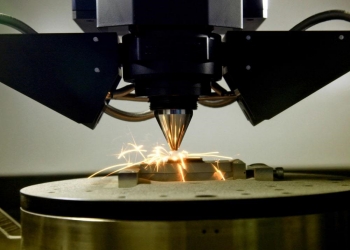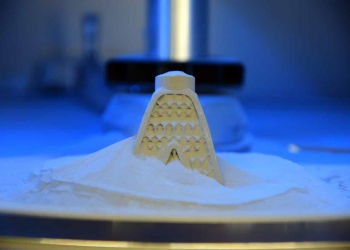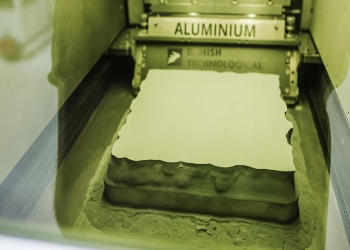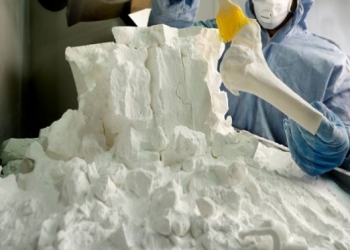Using energy to fuse a bed of powdered materials into solid, complex shapes is one of the most popular patterns of 3D printing. Learn how it works principle and which solution is right for you. If you’ve heard the term “powder bed fusion” 3D printing but aren’t sure what it means, you’ve come to the right place. Powder bed fusion is becoming an increasingly popular term, but it can refer to several different types of 3D printing.

Several methods of 3D printing, also known as additive manufacturing, use powdered materials that are “fused” layer by layer with energy. After printing, the final part is encased in a “bed” of unused powder that must be dug out.
The International Organization for Standardization (ISO) divides 3D printing technology into seven categories, one of which is called powder bed fusion.
Under the ISO powder bed fusion category, there are:
- Selective Laser Sintering (SLS) – Polymers
- Laser Powder Bed Fusion (LPBF) – Metals
- Electron Beam Melting (EBM) – Metals
Despite ISO’s efforts to clarify, the names of technologies and their variants continue to change in the additive manufacturing industry. Not only do 3D printer manufacturers prefer to give their technology a completely new name, but end users of the technology have also developed new abbreviations to refer to processes and methods.
For example, laser powder bed fusion is the name of a technology (developed in Germany nearly 20 years ago) that uses lasers to fuse metal powders into shapes. However, it is also commonly known as Selective Laser Melting, Direct Metal Laser Sintering, Direct Metal Laser Melting (DMLM), Metal Laser Sintering, etc., depending on the manufacturer, but they are all the same technology.
Metal or plastic powder bed
Lasers are also used for polymer powder bed fusion, often called selective laser sintering (SLS). You may also hear the terms “polymer laser powder bed fusion” and “metal laser powder bed fusion” from people who like precision, but that’s not the norm yet.
To further confuse the topic, other 3D printing technologies include powder beds, not typically considered powder bed fusion. One of them is adhesive jetting. This method uses a liquid adhesive to bind metal, ceramic or plastic powders together. These are not included in ISO’s PBF category because no energy is used to fuse the powder during printing. However, heat is often used after the printing process.
Powder Bed Fusion 3D Printer is a 3D printing technology based on the principle of fusion deposition of powder materials. The printing nozzle moves along a designated path during the printing process, melting and stacking the powder material layer by layer, ultimately forming a three-dimensional solid.
Advantages of powder bed fusion 3D printers
High precision: Thanks to laser beams or electron beams for melting, high-precision printing is possible.
Wide range of materials: print various metals, plastics and other powder materials.
Can process complex structures: Through multi-axis linkage and precision control, complex three-dimensional structures can be printed.
Environmentally friendly: powder materials can be reused, reducing waste.
The powder bed fusion 3D printer is an advanced manufacturing technology with many applications
In aviation, powder bed fusion 3D printing technology fabricates aircraft parts, such as engine parts, frame structures, etc. This technology can reduce the number of parts, lower manufacturing costs, and improve production efficiency.

In the automotive field, powder bed fusion 3D printing technology is used to manufacture automotive parts, such as engine parts, gas bottles, exhaust systems, etc. This technology can create complex three-dimensional structures, improving part performance and appearance quality.

In the medical field, powder bed fusion 3D printing technology is used to manufacture medical equipment, medical devices and biomaterials. For example, it can make artificial joints, teeth, and bones. This technology can create medical devices that meet personalized needs and improve treatment effects.

In addition, powder bed fusion 3D printing technology can be used in construction, jewelry, art and other fields. For example, it can be used to make architectural models, jewelry, etc.
Supplier
Luoyang Tongrun Nanotechnology Co, Ltd., as a global chemical material purveyor and manufacturer with over 12 years of experience, is highly trusted for providing high-quality chemicals and nanomaterials such as graphite powder, zinc sulfide, nitride powder, calcium nitride, Ca3N2, 3D printing powder, concrete foaming agent, etc.
We usually transport our goods using DHL, TNT, UPS, and FedEx.You can choose T/T(USD), Western Union, Paypal, Credit card, Alipay or Alibaba trade insurance for payment. Please inquire if you want to buy a high-quality 3D printing powder; we will help.